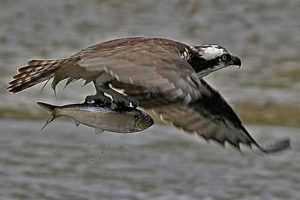Bird Netting and Entanglement
Why Netting
When visiting the fish ladder, you may notice netting covering most of the pools. The netting is intended to keep gulls from attacking alewives as they ascend the fish ladder. In a natural stream, it would be reasonable for gulls—and other wildlife—to indulge freely in such a delectable food source, but in the manmade setting of the fish ladder, the gulls are devastating to our goal of restoring the alewife population.
When the pools are left uncovered with netting, the gulls stand on top of the pool walls and dive after fish, driving fish to the bottom of the pool and thoroughly disrupting the run. After such gull attacks, the counts of fish entering the lake to spawn decline precipitously for several hours. This is very disturbing to those of us who have worked so hard to restore the run, especially because some fish actually fall back and exit the fish ladder after a gull incident, thereby reducing the number of alewives entering the lake to spawn.
Gulls have an opportunity to feast—and you can watch how successful they are at catching alewives and swallowing them whole—in the stream leading up to the fish ladder and harvesting area. The netting protects alewives in the fish ladder pools, where the fish are most vulnerable and gull attacks completely disrupt the run, but there is no need to feel sorry for the gulls. During the alewife run, gulls feast until they are glutted. In fact, be sure to catch the show—gulls diving for alewives, fishing over alewives, and swallowing them whole is one of the most photographed events at the fish ladder!
Entanglement
When the bird netting is set up each spring, great care is taken to avoid gaps that would allow birds and other “critters” from getting caught under the netting. Still, even with such care, the occasional bird gets under the netting. What should you do if you see a bird (or other animal) under the netting?
Please, please, please, call for help! Do not attempt to release the bird yourself! If you want to help, ask everyone who sees the bird to quietly leave the area, call for help, and leave the area yourself. Birds are most likely to get seriously injured when they are frightened.
Several members of the restoration team have been trained to deal with bird entanglement by US Fish and Wildlife Service and Maine Inland Fish and Wildlife Service personal. If you see an entangled bird, please call one of these people, who are either close by or who can enlist the help of other trained personnel.
- Mark Becker – 207-380-7996
- Deb Wilson – 207-380-6997
Thanks very much for your understanding.

Bird Netting and Entanglement
Why Netting
When visiting the fish ladder, you may notice netting covering most of the pools. The netting is intended to keep gulls from attacking alewives as they ascend the fish ladder. In a natural stream, it would be reasonable for gulls—and other wildlife—to indulge freely in such a delectable food source, but in the manmade setting of the fish ladder, the gulls are devastating to our goal of restoring the alewife population.
When the pools are left uncovered with netting, the gulls stand on top of the pool walls and dive after fish, driving fish to the bottom of the pool and thoroughly disrupting the run. After such gull attacks, the counts of fish entering the lake to spawn decline precipitously for several hours. This is very disturbing to those of us who have worked so hard to restore the run, especially because some fish actually fall back and exit the fish ladder after a gull incident, thereby reducing the number of alewives entering the lake to spawn.
Gulls have an opportunity to feast—and you can watch how successful they are at catching alewives and swallowing them whole—in the stream leading up to the fish ladder and harvesting area. The netting protects alewives in the fish ladder pools, where the fish are most vulnerable and gull attacks completely disrupt the run, but there is no need to feel sorry for the gulls. During the alewife run, gulls feast until they are glutted. In fact, be sure to catch the show—gulls diving for alewives, fishing over alewives, and swallowing them whole is one of the most photographed events at the fish ladder!
Entanglement
When the bird netting is set up each spring, great care is taken to avoid gaps that would allow birds and other “critters” from getting caught under the netting. Still, even with such care, the occasional bird gets under the netting. What should you do if you see a bird (or other animal) under the netting?
Please, please, please, call for help! Do not attempt to release the bird yourself! If you want to help, ask everyone who sees the bird to quietly leave the area, call for help, and leave the area yourself. Birds are most likely to get seriously injured when they are frightened.
Several members of the restoration team have been trained to deal with bird entanglement by US Fish and Wildlife Service and Maine Inland Fish and Wildlife Service personal. If you see an entangled bird, please call one of these people, who are either close by or who can enlist the help of other trained personnel.
- Mark Becker – 207-380-7996
- Deb Wilson – 207-380-6997
Thanks very much for your understanding.




